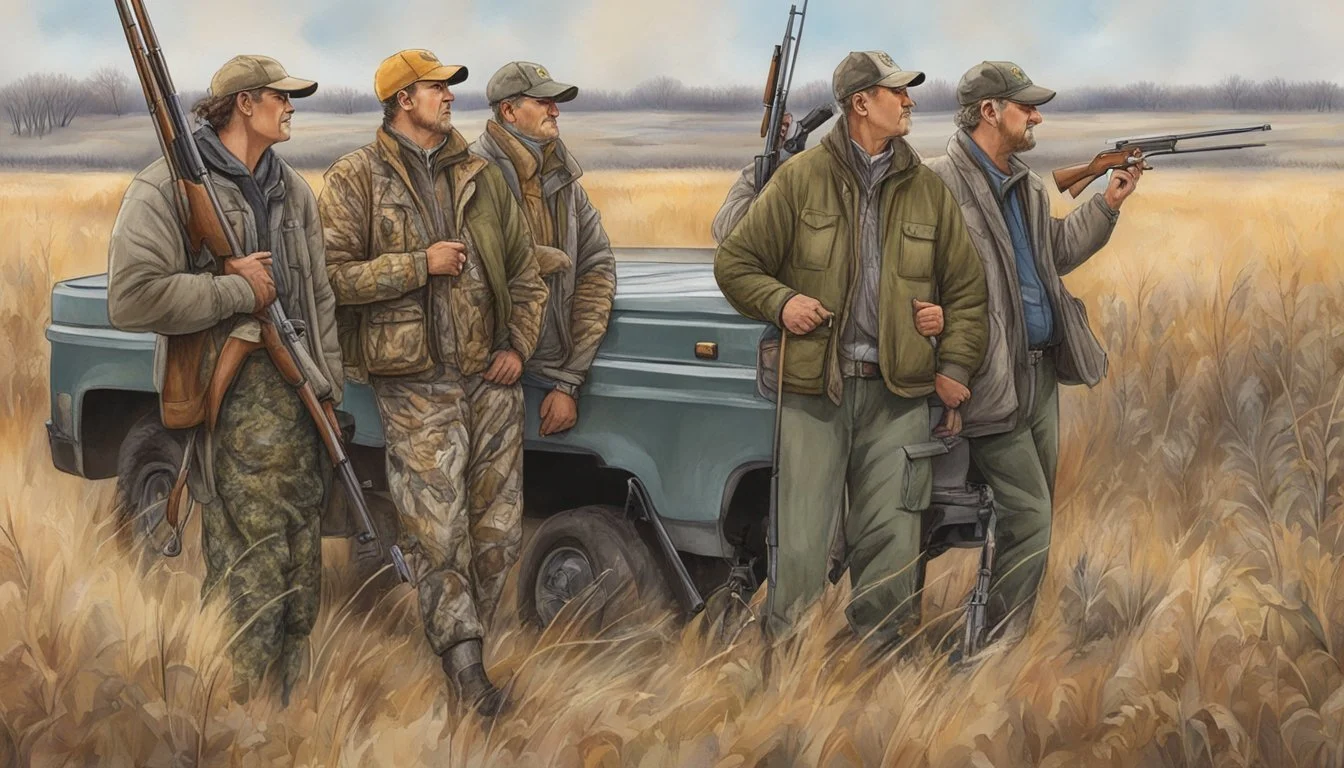Hunting Leases Nebraska
Your Guide to Securing Prime Land
Nebraska offers a variety of hunting opportunities, which include big game species such as whitetail deer and small game & furbearers. The state's diverse landscapes provide excellent habitats for a wide range of wildlife. As such, hunting is a popular activity for both residents and nonresidents, adding to the state's outdoor recreation and heritage.
To access private lands for hunting, individuals often enter into hunting leases—a practice that has become a common way to secure exclusive hunting rights on private property. These agreements are beneficial to both landowners and hunters. Landowners receive a source of income while hunters gain access to prime territories that might otherwise be inaccessible. Across Nebraska, there are numerous leasing options that cater to different hunting preferences, from archery and rifle to muzzleloader hunts.
In Nebraska, hunting leases may vary significantly by location, size, and the type of game available. Regions such as Antelope County and Keya Paha County offer leased lands, reflecting the variety of landscapes and game found throughout the state. The terms of these leases can be just as diverse, ranging from short-term options to longer agreements, enabling hunters to choose leases that best match their hunting schedules and goals.
Understanding Hunting Leases
Hunting leases in Nebraska provide hunters with private land access for wildlife hunting. These agreements are beneficial for both landowners and hunters, establishing clear terms for the use of the land during a specific timeframe. The typical hunting lease can encompass various terms but primarily specifies the location, duration, lease price, and hunting activities allowed.
Location: The location is crucial, as it dictates the type of wildlife available and the overall hunting experience. Nebraska, for example, offers diverse habitats, from the rolling Sandhills to riverine settings, each providing a home to different game species.
Land for Lease: A range of properties may be available, from small acreages to extensive tracts of land, suitable for individual hunters or larger hunting parties. Land conditions and available game can vary, reflecting in the lease arrangements.
Lease Price: Determined by various factors, including land size, game abundance, and amenities provided. Prices are typically set per acre but can also be influenced by market demand and the land’s attributes.
Hunting Lease Types: Leases can range from short-term day agreements to longer seasonal or annual contracts, offering varying degrees of flexibility for hunters. Some leases come with the option to renew, encouraging sustainable hunting practices.
Through such leases, landowners can generate income from their land, contributing to the local economy. Hunters gain access to managed areas which can offer a more isolated and potentially rewarding hunting experience. It's important for both parties to understand their rights and responsibilities before entering into a lease agreement.
Types of Game and Hunting Seasons
Nebraska offers a diverse range of hunting experiences, from pursuing large game such as deer and turkey (What wine goes well with turkey?) to engaging in the sport of waterfowl hunting. The state's defined hunting seasons are designed to provide ample opportunities for hunters while managing wildlife populations effectively.
Deer Hunting in Nebraska
The state is home to both mule deer and whitetail deer, providing hunting enthusiasts with choices for their preferred game. For whitetail deer, the rifle season usually opens in November and offers a chance for hunters to bag a trophy buck. Meanwhile, mule deer, favoring the rougher terrain of Nebraska, have specific zones and seasons dedicated to their pursuit to ensure proper management.
Archery: September 1 - December 31
November Firearm: November 16 - November 24
Muzzleloader: December 1 - December 31
Turkey and Upland Game
Turkey hunting in Nebraska attracts numerous sportsmen and women each year, especially for the spring and fall seasons. The state also boasts a variety of upland game such as pheasant, quail (What wine goes well with quail?), and grouse, with specific regions offering better chances for success. Open fields and grasslands are prime habitats for these species, making Nebraska a choice destination for upland game hunters.
Spring Turkey: Dates vary annually
Fall Turkey: September 15 - January 31
Pheasant/Quail/Grouse: Usually opens in late October through January
Waterfowl and Bird Seasons
Nebraska's location within the Central Flyway makes it a hotspot for waterfowl hunting, including duck and goose species like the mallard. Wetlands and rivers provide ideal conditions for waterfowl hunters during migration periods. Other sought-after birds include dove, which offer an early-season hunting opportunity.
Duck: Typically starts in early October through late January (zones may vary)
Goose: Season dates vary, with some extending into February
Dove: September 1 - October 30
As seasons and specific dates can vary annually, it is essential for hunters to check with the Nebraska Game and Parks Commission for the most current information before planning their hunting trips.
Habitats and Wildlife Management
Effective wildlife management and the creation of a productive habitat are crucial for the sustainability of hunting leases in Nebraska. Landowners and hunters invest in such practices to ensure both game and non-game species thrive within these regions.
Food Plots and Natural Forage
For the health and growth of game populations, particularly whitetail deer, food plots are sown with a variety of crops. Corn and soybeans provide carbohydrates essential for antler growth and overall health, while alfalfa offers a rich protein source that is beneficial for both cattle and wildlife. The introduction of milo caters to different wildlife species, adding diversity to the available food sources. Maintaining these food plots not only supports wildlife with nutrition but can also improve the genetics of the herds by allowing them to reach their full potential.
Wetlands and Woodland Habitats
The wetlands of Nebraska, especially around the Platte, North Platte, and South Platte rivers, play a vital role as habitats for migratory birds and other wetland species. Management in these areas often focuses on maintaining natural water sources and vegetation. The conservation and enhancement of woodland habitats, including the management of cedars, are important for maintaining a balance within the ecosystem. In western Nebraska, enhancing woodland areas by controlling invasive species and promoting native flora benefits a multitude of species and increases the ecological value of the hunting grounds.
Hunting Methods and Tactics
In Nebraska, hunters employ a variety of methods and tactics to pursue game such as whitetails. Focusing on stealth and precise timing, they leverage different approaches depending on the hunting season and the regulations governing each.
Archery and Tree Stands
During archery season, hunters frequently use tree stands to elevate themselves above the ground. This tactic offers visual advantage and helps minimize the hunter's scent trail. Archery enthusiasts need to practice safety by using harnesses while in tree stands, and they often aim for deeper draws where deer movement is prevalent to increase chances of encountering bigger deer.
Muzzleloader and Rifle
Muzzleloader and rifle hunters generally seek the balance between range and stealth. For muzzleloader hunting, which occurs before the regular firearm season, hunters may use natural terrain features near fence lines to ambush whitetails moving for food or mates. Rifle hunters, when the season opens, often choose positions that overlook likely deer paths, with a clear line of sight to take a responsible shot.
Ground Blinds and Ambush Points
Constructing ground blinds near active trails or food sources is a common tactic. Hunters using ground blinds blend into the natural surroundings, facilitating an ambush of whitetails, especially during peak feeding times. Safety remains paramount, ensuring clear fields of fire and responsible firearm handling. Siting blinds near fence jumps or known travel corridors can also capitalize on predictable deer movement.
Hunting Rules and Regulations
In Nebraska, hunters are required to adhere to specific rules and regulations to ensure safety and conservation. Age restrictions apply; hunters under the age of 12 are not allowed to hunt big game. Additionally, specific regulations pertain to various hunting seasons, including the designated rifle season, which varies by county and Missouri hunting unit.
Hunting Regulations:
Deer Seasons: Different seasons are designated for archery, muzzleloader, and rifle hunting, each with specific date ranges.
Bag Limits: These are imposed on the number of game animals that can be taken.
Permit Requirements: Prospective hunters must secure the necessary permits for the intended game.
For Knox County, as in other counties, hunters must follow state regulations while also observing guidelines for public and private lands, which may have additional restrictions.
Rifle Season Regulations often include:
Specific dates, usually falling in November.
Legal hunting hours, typically starting 30 minutes before sunrise and ending 30 minutes after sunset.
Nebraska Hunting Regulations mandate:
Hunter education certification for those ages 12 through 29 who are hunting with firearms or archery equipment.
Permission to hunt on private lands, often solidified through hunting leases.
Hunters are encouraged to review the complete regulations provided by the Nebraska Game & Parks Commission to ensure compliance with all the current rules for successful and lawful hunting expeditions.
Lease Amenities and Accommodations
When selecting a hunting lease in Nebraska, prospective lessees consider the amenities and accommodations that can significantly enhance their hunting experience. This includes the availability of camping and lodging options, as well as access to water and distinct terrain features, which are essential for a comfortable and successful hunt.
Camping and Lodging Options
Many hunting leases in Nebraska offer on-site camping areas or proximity to local lodging facilities. This allows hunters to stay close to their hunting site, maximizing their time in the field. Accommodations can range from primitive campgrounds to more equipped cabins, providing options for different preferences and needs.
Camping: On-site or nearby areas designated for tents and recreational vehicles.
Lodging: Cabins or houses available for rent, equipped with basic to full-service amenities.
Access to Water and Terrain Features
The presence of live water on a hunting lease is a desirable feature, as it not only supports wildlife but can also increase deer traffic patterns. Knowledgeable hunters look for leases with lakes, ponds, or rivers, which can be hotspots for game and provide natural blinds or vantage points.
Live Water: Ponds, rivers, or lakes present within the lease boundaries.
Terrain: Varied terrain with ridges, valleys, and open fields that cater to different hunting styles and increase the likelihood of encountering game.
Hunting leases in Nebraska often market themselves as hunting paradises due to their well-managed lands that support abundant wildlife, offering a mix of amenities that cater to the practical needs of hunters.
Evaluating Hunting Property
When looking for a hunting lease in Nebraska, it's crucial to understand both the wildlife patterns and the physical characteristics of the land. This knowledge ensures a fulfilling hunting experience.
Assessing Wildlife and Game Activity
When evaluating a hunting property, paying attention to game trails, feeding areas, and water sources is fundamental. These factors will give you insight into the wildlife's daily movements and behaviors. For deer hunting properties, one should look for signs of activity such as trails, droppings, and bedding areas. A well-populated hunting lease might be considered a deer mecca if evidence of buck activity—such as rub lines and scrapes—is abundant.
Food: Identify areas with crops like corn or beans and natural food sources that attract game.
Water: Look for streams, ponds, or other water bodies that serve as hydration points for wildlife.
Cover: Dense timber, brush, and other foliage provide essential shelter and bedding areas.
Land Features and Access Considerations
Access to the property is just as important as the wildlife it supports. Properties with easy access via roadways or walking paths offer convenient entry points for hunters to set up and take down equipment. Key features such as fingers and pockets in the terrain can be advantageous for strategic stand placement.
Table summarizing key access considerations:
Feature Importance Roads/Trails Provides access for hunters and potential game travel routes. Terrain Types Fingers and pockets can be ideal stand locations for observing game. Borders Must be clearly defined to ensure hunting is contained within the lease.
In summary, successful hunting on leased property necessitates a thorough assessment of both wildlife activity and land features. This approach will guide hunters in making informed decisions about their prospective hunting grounds.
Cost Considerations and Budgeting
When considering a hunting lease in Nebraska, it is essential to take into account various costs associated with leasing land. Landowners typically calculate the lease price by incorporating all management and operational expenses plus an additional percentage to account for unforeseen costs and land-related taxes.
Budgeting for a Hunting Lease:
Base Lease Cost: This includes the initial price of leasing the land, which can be influenced by the quality of the game and the amenities offered by the landowner.
Management Expenses: Expenses related to the upkeep and management of the property should be factored into the overall budget.
Tax Consideration: The lease cost often encompasses the land taxes that the landowner must pay.
Here is a potential budget outline:
Expense Category Description Estimated Cost Range (%) Base Lease Cost The foundational cost for land use. 70-80% Management & Operations Upkeep, improvements, and running of the lease. 10-20% Contingency & Taxes Unplanned expenses and taxation on the property. 10-15%
It is important for those interested in leasing land for hunting to understand the breakdown of these costs. One should inquire specifically about any additional fees or requirements that may not be immediately apparent, ensuring a clear and comprehensive budget is established. Landowners may utilize various methods to determine the final price, such as the breakeven point including labor costs, and then add a percentage to cover additional contingencies. Prospective lessees should thoroughly review the lease agreement to understand the full scope of financial obligations.
Safety and Hunting Ethics
When engaging in hunting activities on leased land in Nebraska, individuals must prioritize safety and ethical practices. Regulations and guidelines are established to ensure that hunting remains a safe activity for everyone involved, including hunters, landowners, and the general public.
Safety is paramount, and hunters are expected to adhere to Nebraska's hunting regulations to prevent accidents and injuries. They should always handle firearms with care, be aware of their surroundings, and never shoot unless they have a clear, identified target and a safe backdrop. Wearing hunter orange is a mandated precaution during certain seasons, making hunters more visible to others.
Hunting regulations are not only legal requirements but also underpin the ethics of responsible hunting. Hunters must have the proper licenses and follow game laws, including seasons, bag limits, and specific rules concerning the use of blinds and stands. Here's a brief overview of state requirements:
Hunting Licenses: Required for all hunters.
Seasons and Bag Limits: Set for various game to manage populations.
Blinds and Stands: May have restrictions based on location.
Landowners who lease their property for hunting purposes should also ensure that their leases clearly outline the preservation of habitat and respect for wildlife. They should:
Communicate: Clearly state the areas where hunting is allowed.
Conservation: Encourage sustainable hunting practices.
Ultimately, the state promotes a 'fair chase' philosophy. This means hunters must not gain an improper advantage over their quarry and should conduct themselves in a manner that is respectful of natural resources and the rights of others. Upholding these principles ensures hunting traditions in Nebraska are conserved for future generations.






